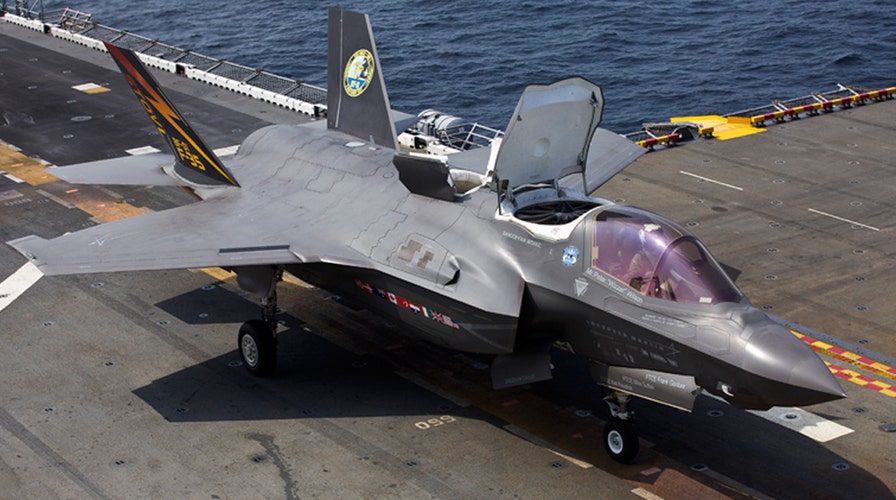War Games: F-35A Lightning II fighter gets new gun
Tech Take: Allison Barrie discusses the new gatling gun being deployed on the F-35A Lightning II jet fighter
Ultra advanced stealth, fighter jet speed … and now the military’s F-35 has a new weapon.
The F-35 Lightning II is a truly fifth-generation fighter jet. This advanced powerful single-seat and single-engine fighter is designed to be capable of a range of missions with just one aircraft.
Test pilot Maj. Charles "Flak" Trickey recently fired the F35A’s internal Gun Airborne Unit -22/A 25mm Gatling gun system in three airborne gunfire bursts. A success, this first aerial gun test was conducted out at the China Lake, Calif., test range on Oct. 30 2015.
Related: 11 stunning F-22 fighter jet images
This is a key step in certifying the gun for use in the F-35A and the aircraft is on track to enter initial operational capability with the U.S. Air Force next year.
The F-35 is the result of collaboration between prime contractor Lockheed Martin and principal partners Northrop Grumman and BAE Systems.
Next-Gen Air Dominance
Stealth was built into this aircraft from the very start. The F-35 also possesses other fifth-generation features like integrated avionics, sensor fusion and incredibly powerful sensor packages.
The Pratt & Whitney F135 propulsion system gives the aircraft phenomenal power – it is able to reach speeds of over 1199 mph.
With this new gun, pilots will have the ability to engage air-to-ground and air-to-air targets. The 25mm gun is embedded into the F-35A's left wing in a way that keeps the aircraft stealthy.
Over the next year, testing will continue with the gun integrated into the fighter's sensor fusion software. The software will provide targeting data to the pilot through the pilot’s state of the art helmet-mounted display.
Related: 11 amazing A-10 Warthog images
Even the helmets on this aircraft are next generation. Pilots wearing them can see through the aircraft and the heads up display provides unprecedented data. Each pilot gets a personalized version.
Rather than deploy different aircraft specializing in different things, the F-35 can tackle a range of tasks by itself. Highly versatile, the F-35 can handle missions like air-to-air combat, electronic attack, intelligence, surveillance, reconnaissance and air-to-ground strikes.
Stealth
The F-35 gives pilots the ability to penetrate deep into enemy areas without being detected. The advanced materials and airframe design mean that F-35s can evade radars that other fighters cannot. The plane can get through highly defended air spaces without ever being detected and then clear the way for U.S. forces.
Using weapons like precision-guided munitions and air-to-air radar-guided missiles, the pilots can engage long-range ground targets without being detected and tracked by the enemy.
Combat
When faced with enemy fighter aircraft, the F-35s have a number of advantages. For starters, the F-35 pilots will be able to detect the enemy aircraft long before they are detected themselves. In aerial combat, this means the F-35 can take lethal action first. The fighter’s weapons systems will also give it a big advantage over enemy aircraft.
Related: What you need to know about the new U.S. Air Force stealth bomber
Pilots can leverage the aircraft’s advanced electronic warfare abilities to
locate and track enemy forces. To reach highly protected targets, pilots can jam enemy radars and disrupt attacks on their aircraft using the advanced avionics system.
In an F-35, pilots have 360-degree real time battlespace data. The sensor package is state-of-the-art and any data the sensors collect can be securely shared with commanders all over the world, giving them a more complete picture of operations as they unfold.
The aircraft has a core processor that can perform a mind-blowing 400 billion operations per second.
This helps enable next-gen electronic warfare and intelligence, surveillance and reconnaissance, but also helps to recommend the next target to attack and the best weapon to use.
Replacing Classic Fighters
Over the years, U.S. fighter fleets have been aging and becoming smaller.
There are three variants of the F-35, all of which will be replacing military aircraft. F-35A takes off and lands conventionally. The F-35B is capable of short-take off and vertical-landing and the F-35C is carrier-based.
For the U.S. Air Force, the F-35 variants will replace the A-10 Thunderbolt II and F-16 Fighting Falcon. For the U.S. Navy, they will replace the F/A-18 Hornet. The U.S. Marine Corps will be replacing the F/A-18 and AV-8B Harrier with F-35s.
Ballet dancer turned defense specialist Allison Barrie has traveled around the world covering the military, terrorism, weapons advancements and life on the front line. You can reach her at wargames@foxnews.com or follow her on Twitter @Allison_Barrie.

